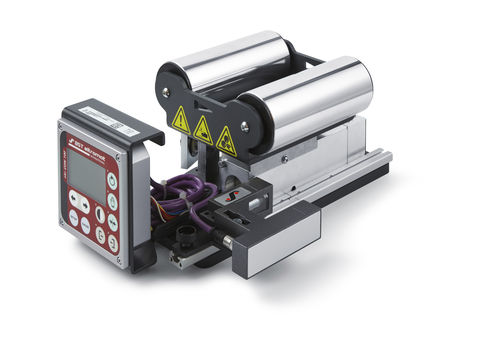Business
How Does a CO2 Laser Work? An In-Depth Look at the Mechanisms and Applications

CO2 lasers have become essential tools in various industries, ranging from manufacturing and healthcare to scientific research. Known for their high power, precision, and versatility, CO2 lasers are used for cutting, engraving, and surgical procedures. Understanding how a CO2 laser works provides insight into its applications and benefits. This article How Does a CO2 Laser Work delves into the fundamental principles of CO2 laser operation, exploring its components, processes, and technological advancements.
The Basics of CO2 Lasers
A CO2 laser, or carbon dioxide laser, utilizes carbon dioxide gas as its primary lasing medium. To comprehend its functionality, it is crucial to understand the core principles and components involved in its operation.
Core Components of a CO2 Laser
- Laser Medium
- The lasing medium in a CO2 laser consists of a mixture of carbon dioxide (CO2), nitrogen (N2), and helium (He) gases. The CO2 molecules are the primary source of laser light, while nitrogen and helium assist in energy transfer and heat dissipation.
- Electrical Discharge
- An electrical discharge or electrical current is used to excite the gas molecules in the laser medium. This excitation process is crucial for generating laser light.
- Laser Cavity
- The laser cavity is a chamber where the lasing action occurs. It contains two mirrors positioned at each end of the cavity: one highly reflective mirror (the end mirror) and one partially reflective mirror (the output coupler). These mirrors form an optical resonator that amplifies the light.
- Output Coupler
- The output coupler is a partially reflective mirror that allows a portion of the amplified laser light to exit the laser cavity as a coherent beam. It plays a critical role in determining the characteristics of the emitted laser beam.
How CO2 Lasers Generate Laser Light
The process of generating laser light in a CO2 laser involves several stages:
- Excitation of Gas Molecules
- When an electrical current passes through the gas mixture in the laser cavity, it excites the CO2 molecules to higher energy levels. This excitation causes the molecules to become unstable.
- Stimulated Emission
- As the excited CO2 molecules return to their ground state, they release photons (light particles) in a process known as stimulated emission. These photons have a specific wavelength, typically around 10.6 micrometers, which falls in the infrared spectrum.
- Photon Amplification
- The emitted photons travel back and forth between the two mirrors in the laser cavity. Each pass through the cavity amplifies the light due to further stimulated emission and reflection within the cavity.
- Beam Formation
- A portion of the amplified light escapes through the partially reflective output coupler. This coherent and intense beam of light is what is utilized in various applications.
The Advantages of CO2 Lasers
CO2 lasers offer several advantages that make them highly effective for specific applications:
- High Power Output
- CO2 lasers are capable of producing high power outputs, making them suitable for cutting and engraving materials with precision and efficiency. Their ability to focus a high-intensity beam allows for clean and effective processing.
- Precision and Accuracy
- The focused beam of a CO2 laser ensures precise cutting and engraving, making it ideal for applications requiring high accuracy. This precision is beneficial in fields such as manufacturing, medical procedures, and scientific research.
- Versatility in Material Processing
- CO2 lasers can process a wide range of materials, including metals, plastics, wood, glass, and textiles. This versatility makes them valuable tools in various industries, from aerospace and automotive to fashion and healthcare.
- Non-Contact Operation
- CO2 lasers operate in a non-contact manner, meaning they do not physically touch the material being processed. This characteristic reduces wear and tear on tools and minimizes the risk of contamination or damage to delicate materials.
- Low Maintenance
- CO2 lasers generally require low maintenance compared to other types of lasers. Their robust design and the absence of moving parts in the laser cavity contribute to their reliability and longevity.
Applications of CO2 Lasers
The versatility of CO2 lasers makes them suitable for a wide range of applications across different industries:
- Industrial Cutting and Engraving
- CO2 lasers are extensively used for cutting and engraving materials such as metals, plastics, wood, and glass. Their precision and high power output make them ideal for manufacturing processes, signage production, and decorative items.
- Medical Procedures
- In the medical field, CO2 lasers are employed for various surgical procedures, including skin resurfacing, tumor removal, and eye surgeries. The precision and controlled energy of CO2 lasers allow for minimally invasive procedures with reduced risk of bleeding and scarring.
- Aerospace and Automotive Industries
- CO2 lasers are used in the aerospace and automotive industries for applications such as component manufacturing, material testing, and repair. Their ability to process complex and high-strength materials is essential in these sectors.
Innovations and Future Directions
The field of CO2 laser technology continues to evolve, with ongoing research and innovations aimed at improving performance and expanding applications:
- Advanced Laser Designs
- Researchers are exploring new designs and configurations for CO2 lasers to enhance their power output, beam quality, and efficiency. Innovations such as advanced optics and improved gas mixtures are expected to drive future advancements.
- Automation and Integration
- The integration of CO2 lasers with automation and robotics is transforming manufacturing processes. Automated systems offer increased precision, speed, and flexibility, leading to improvements in production efficiency and quality.
- Emerging Applications
- New applications for CO2 lasers are being discovered, including advancements in medical treatments, environmental monitoring, and materials science. The adaptability of CO2 lasers makes them a promising technology for future developments.
Conclusion
CO2 lasers are powerful and versatile tools that play a critical role in various industries and applications. Understanding how a CO2 laser works provides valuable insights into its capabilities and benefits. By utilizing carbon dioxide gas as the lasing medium and employing sophisticated optical systems, CO2 lasers achieve high power, precision, and efficiency.
From industrial cutting and engraving to medical procedures and scientific research, CO2 lasers continue to drive innovation and progress. As technology advances and new applications emerge, CO2 lasers will remain at the forefront of optical technology, shaping the future of precision and performance in numerous fields.
Business
Understanding the Web Guide Controller: An Essential Component in Modern Manufacturing

In the field of industrial automation, the web guide controller is a fundamental tool that ensures the accurate alignment of web materials throughout various manufacturing processes. This article delves into the functions, benefits, applications, and future trends associated with web guide controller, providing a comprehensive overview of their critical role in modern production environments.
What Is a Web Guide Controller?
A web guide controller is a device designed to manage and correct the alignment of web materials, such as paper, film, and foil, during manufacturing. It employs a combination of sensors and control mechanisms to maintain precise positioning and alignment, which is crucial for high-quality production.
How Web guide controller Operate
At the core of a web guide controller is its ability to detect deviations in material alignment using advanced sensors. These sensors continuously monitor the position of the web material and feed this data to the control unit. The controller then makes real-time adjustments to correct any misalignment, ensuring the material remains properly aligned throughout the production process.
Key Benefits of Using a Web Guide Controller
Incorporating a web guide controller into your production line offers several significant advantages that enhance both efficiency and quality:
Enhanced Alignment Precision
Web guide controller provide exceptional precision in aligning web materials. This precision is crucial for preventing defects and ensuring that finished products meet exact specifications. The ability to maintain accurate alignment contributes directly to product quality and consistency.
Reduction in Material Waste
By ensuring that web materials are correctly aligned, web guide controller help minimize waste caused by misalignment. This reduction in waste not only lowers production costs but also supports more sustainable manufacturing practices by maximizing material usage.
Increased Production Efficiency
The automated nature of web guide controller streamlines the production process by reducing the need for manual adjustments and interventions. This automation leads to faster production cycles and improved overall efficiency, making the manufacturing process more cost-effective.
Improved Product Quality
Consistent alignment achieved through web guide controller enhances quality control. Products produced with precise alignment are less likely to exhibit defects, ensuring they meet or exceed industry standards and customer expectations.
Applications of Web guide controller
Web guide controller are versatile devices with applications across various industries. Here’s an overview of their key uses:
Printing and Publishing
In the printing and publishing industry, web guide controller are used to align paper, film, and other substrates during the printing process. Accurate alignment is essential for ensuring that printed content, such as text and images, is correctly positioned and free from errors.
Packaging
In the packaging sector, web guide controller manage the alignment of packaging materials, including labels and films. Proper alignment is crucial for accurate label placement and effective packaging, which impacts product presentation and functionality.
Textile Production
Web guide controller are employed in textile production to align fabrics during processing stages such as coating and finishing. Accurate alignment ensures that treatments and coatings are applied evenly, resulting in high-quality textile products.
Film and Foil Manufacturing
For film and foil manufacturing, web guide controller help maintain alignment during coating and processing. Proper alignment is vital for producing films and foils that meet industry specifications and performance standards.
Emerging Trends and Innovations
As technology advances, web guide controller are expected to evolve in several key areas:
Integration with Intelligent Systems
Future web guide controller are likely to integrate with intelligent systems, such as artificial intelligence and machine learning. These advancements will enable controllers to analyze data more effectively and make precise adjustments in real time, enhancing overall performance.
Enhanced Connectivity and Data Integration
Improved connectivity will allow web guide controller to interface more seamlessly with other production equipment. This enhanced data integration will facilitate better coordination and optimization of manufacturing processes.
Greater Flexibility and Adaptability
The next generation of web guide controller will offer increased flexibility, allowing them to handle a wider range of materials and production conditions. This adaptability will make them suitable for diverse applications across different industries.
Focus on Energy Efficiency
Sustainability will become a significant focus in the development of web guide controller. Innovations may include energy-efficient designs that reduce power consumption and support environmentally friendly manufacturing practices.
Conclusion
The web guide controller is an indispensable tool in modern manufacturing, playing a critical role in maintaining precise alignment of web materials and optimizing production processes. By leveraging advanced sensors, real-time adjustments, and robust mechanical components, web guide controller contribute to enhanced precision, reduced waste, and improved product quality.
Their applications span across various industries, including printing, packaging, textile production, and film manufacturing. As technology continues to evolve, web guide controller are expected to incorporate intelligent systems, enhanced connectivity, and increased flexibility, further enhancing their capabilities and applications.
In summary, web guide controller are essential for achieving high-quality production and operational efficiency. Their ability to provide accurate alignment and automate adjustments underscores their importance in meeting industry demands and maintaining competitiveness.
Business
Revolutionizing Web Development: The Indispensable Role of NodeJS

Web development has drastically changed in the past few years with the emergence of modern frameworks and libraries that simplify the process and improve developer experience. NodeJS is one such revolutionary technology that has completely transformed the web development landscape, making it more agile, flexible, and scalable. NodeJS is a server-side JavaScript runtime environment, built on the Chrome V8 engine, which enables developers to create fast and efficient web applications. This blog post will delve into the indispensable role NodeJS plays in modern web development and why it has become the preferred choice for developers worldwide. In our present digital age, efficiency is the cornerstone of any successful website development project. NodeJS stands out in this regard. Its event-driven nature facilitates efficient handling of concurrent client requests, providing swift responses, and thus, significantly boosting the performance of web applications.
1. Speed and Scalability
One of the most significant advantages of NodeJS website development is its speed and scalability. Due to its non-blocking I/O model, Node can handle many connections at once, ensuring applications remain responsive even under heavy loads. This scalability is critical to meet the demands of today’s users, who expect real-time updates and seamless user experiences. Moreover, NodeJS’s speed makes it ideal for creating lightweight, performant APIs that can handle a massive amount of data with ease. NodeJS is not just about efficiency, it’s also about building robust, scalable web solutions. With its single-threaded model and event-driven architecture, NodeJS is primed to handle heavy traffic and deliver high-end performance, making it an excellent choice for developing large-scale applications.
2. Cross-Platform Compatibility
NodeJS website development is a cross-platform technology that can run on different operating systems, including Windows, Linux, and MacOS. This compatibility enables developers to create applications that can run in any environment, making it easier to deploy and manage applications for diverse user bases. Additionally, NodeJS’s modularity, which allows developers to use modules and packages based on their specific needs, makes it easier to handle dependencies and streamline the development process. NodeJS is also an ideal technology for developing scalable and efficient microservices architecture, as it breaks large monolithic environments into smaller-functional components. By using NodeJS to build microservices, developers can create small and manageable modules that communicate with each other through APIs. This architecture allows for better scalability, durability, and improved crash resistance. NodeJS also supports a wide range of databases, including NoSQL databases such as MongoDB, making it an ideal tool for developing database-centric applications.
3. Rich Ecosystem and Community Support
NodeJS website development has a vast collection of modules and packages available in its ecosystem, which makes it easier for developers to create applications with pre-built components. The NPM (Node Package Manager) repository is home to over 1 million modules that can be added to applications, saving developers a significant amount of time and effort. Furthermore, NodeJS has a thriving community of developers who are continually updating and improving the platform, making it easier for others to contribute to and enhance the ecosystem.
4. Microservices and DevOps
NodeJS is incredibly well-suited to the development of microservices, which are small, independent services that act together to form a complete application. Microservices architecture allows developers to create scalable, modular, and easily maintainable applications. Moreover, DevOps teams can use NodeJS to automate application deployment, testing, and monitoring, reducing the time and effort required to maintain application stability and uptime.
5. Future of Web Development
While NodeJS has been a game-changer in web development, and remains an essential technology for creating modern web applications, its benefits extend beyond in-house development teams. The rise of web development outsourcing makes NodeJS’s features even more attractive. Its speed, scalability, and cross-platform compatibility make it a perfect choice for outsourced teams working on projects with tight deadlines and ever-changing requirements. NodeJS also provides developers with an added level of flexibility that enables them to work on both the client-side and server-side of their applications. Using the same language to code across both client and server-side means that developers can create more complex applications with less complexity and optimize their applications more effectively. It also means that they can easily reuse code across different projects, enabling the efficient creation of similar but slightly different web applications.
Conclusion
NodeJS has revolutionized web development by enabling developers to create fast, efficient, and scalable applications that can run on any platform. Its rich ecosystem, cross-platform compatibility, and community support have made it popular among developers worldwide, and it continues to evolve to meet the demands of modern web development. As more businesses move towards digital transformation, NodeJS is poised to play an even more critical role in web development and is set to be an essential technology for developers for years to come. With its high scalability and performance, NodeJS has undeniably changed the game for dynamic website development. But evolution doesn’t stop here. As we look ahead, it’s clear that NodeJS will continue to play a vital role in the future of web development, pushing the boundaries of what’s possible and paving the way for the next web revolution.
Business
10 Unique Custom Keychain Ideas to Showcase Your Personality

In today’s world, where self-expression is cherished, custom keychains have emerged as a popular accessory to showcase one’s personality. Gone are the days of generic keychains; instead, individuals are opting for personalized options that reflect their unique interests, hobbies, and quirks. If you’re looking to add a touch of individuality to your everyday carry, here are 10 unique custom keychain ideas to consider:
- Miniature Book Keychain
For the bookworms and literary enthusiasts, a miniature book keychain is the perfect accessory to flaunt your love for reading. Customize the cover with your favorite book title or author’s name, and carry a piece of literature wherever you go.
- Retro Cassette Tape Keychain
Nostalgia meets functionality with a retro cassette tape keychain. Whether you’re a music aficionado or simply appreciate vintage aesthetics, this custom keychain is sure to turn heads. Personalize it with your favorite album or mixtape for a unique touch.
- Puzzle Piece Keychain Set
Celebrate the bond of friendship or love with a puzzle piece keychain set. Each piece can be customized with initials, dates, or symbols that hold significance to you and your loved ones. When connected, the keychains form a complete picture, symbolizing unity and connection.
- Travel Destination Keychain
Capture your wanderlust adventures with a custom keychains featuring your favorite travel destinations. Whether it’s the iconic skyline of New York City or the serene beaches of Bali, let your keychain serve as a reminder of the places you’ve explored and the memories you’ve made.
- Vintage Camera Keychain
Photography enthusiasts will appreciate a vintage camera keychain that pays homage to their passion. Customize the keychain with intricate details and personalize it with your initials or a meaningful quote. It’s a stylish accessory that reflects your artistic flair.
- Constellation Keychain
Astrology enthusiasts can showcase their zodiac sign with a constellation keychain. Each keychain features the unique arrangement of stars corresponding to your astrological sign, making it a personalized accessory that reflects your cosmic identity.
- Pet Portrait Keychain
For pet lovers who want to keep their furry friends close at all times, a custom pet portrait keychain is the ideal choice. Simply provide a photo of your beloved pet, and watch as it’s transformed into a miniature masterpiece that you can carry wherever you go.
- Custom Soundwave Keychain
Turn your favorite song, quote, or message into a unique visual representation with a custom soundwave keychain. Each keychain features the waveform of your chosen sound, creating a one-of-a-kind accessory that is both visually striking and deeply personal.
- Handwritten Message Keychain
Capture a moment in time with a handwritten message keychain. Whether it’s a love note from a significant other, a heartfelt message from a friend, or words of wisdom from a family member, transform handwritten sentiments into a wearable keepsake that holds sentimental value.
- Abstract Art Keychain
Let your creativity shine with an abstract art keychain that reflects your unique sense of style. Whether you prefer bold colors and geometric shapes or subtle brushstrokes and organic forms, customize your keychain with an abstract design that speaks to you.
FAQs:
Q: How do I go about creating a custom keychain? A: Many online retailers offer customizable keychain options where you can upload your own images or choose from a variety of pre-designed templates. Simply select your preferred design, add personalization details, and place your order.
Q: Are custom keychains expensive? A: The cost of custom keychains varies depending on factors such as materials, design complexity, and customization options. While some options may be more affordable, others may come with a higher price tag for intricate designs or premium materials.
Q: Can I use custom keychains as gifts for special occasions? A: Absolutely! Custom keychains make thoughtful and personalized gifts for birthdays, anniversaries, graduations, and other special occasions. Whether it’s a portrait of a beloved pet or a soundwave of a meaningful song, custom keychains are sure to be cherished by the recipient.
Conclusion:
Custom keychains offer a creative and stylish way to showcase your personality and interests. Whether you opt for a nostalgic cassette tape keychain or a personalized pet portrait keychain, there are endless options to choose from. By selecting a custom keychain that resonates with you, you can carry a piece of your identity wherever you go. So why settle for a generic keychain when you can make a statement with a personalized accessory that is uniquely yours?
-

 Entertainment3 years ago
Entertainment3 years agoHow to Get Positive Feedback by Using Straight Tuck End Boxes
-

 Lifestyle3 years ago
Lifestyle3 years ago13 Beautiful Decor Ideas to Add Personality to Your Hallway
-

 Quote4 years ago
Quote4 years ago100+ Amazing Memorable College Life Quotes| Recall Old Days
-

 Quote4 years ago
Quote4 years agoBest 100+ Heart Touching One Side Love Quotes For Him/Her
-

 Quote3 years ago
Quote3 years ago50+ Famous KGF Movie Dialogues | Rocky Bhai
-

 Travel3 years ago
Travel3 years agoIraqi Dinar: A Bold Move That Could Make Or Break The Currency
-

 Status3 years ago
Status3 years ago201+ Love Feeling Status for Couple in English | 2022
-

 Status3 years ago
Status3 years ago175+ Missing Someone Quotes For Beloved, Family, Your Friends, Your Sweetheart

